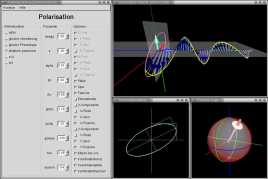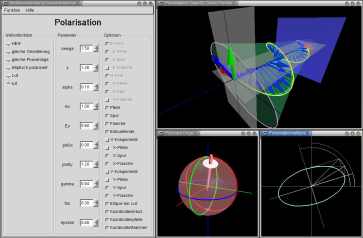| Home |
| News |
| Description |
| Screenshots |
| Download |
| Requirements |
| SourceForge |
| Contact |
| Todo |
| News | ||||||||||
| ||||||||||
| Description | ||||||||||
|
Electromagnetic waves are an ubiquitous phenomenon in our daily life. Radio, television, cellular and even light are concerned with them. Electrical and communications engineering is the science coping with them. Students in this subject have to be familiar with electromagnetic waves. Embarrassingly they are quite difficult to understand and to visualize. This project GLWaves is inteded to assist in exactly that task. GLWaves is written in FreePascal and runs on Linux. But beside rewriting the user interface, which is based on GTK, it should be quite easily portable to other platforms. OpenGL is used to visualize 3D images and animations allowing an easy to understand and graphic presentation. It is recommended that you have a hardware accelerated 3D graphic card. On a Pentium III 800Mhz a relatively complex scene in the 400x300 pixel window gets flickering a bit but doesn't annoy. If you can live with that, you probably don't need a 3D graphic card. In the current state GLWaves has simulations for
After starting GLWaves it offers a standard menu bar where you can choose the demo you want to run. After selecting one, the main window enlarges to fill in a list of sub-demos, adjustable parameters and options what to display and what not. A second window is opened with the 3D animation. On demand additional windows are opened to show parameters like the Poincare sphere. Selecting another demo closes the previously opened window and opens a new one with the chosen demo. This program is a university project at the University of technology, Vienna, Austria. So all texts and descriptions are held in German. Translating GLWaves to other languages (especially English) is a thing to be done in the future. All comments and symbol names are in English. GLWaves is distributed under the terms of the
GNU General Public
License (GPL). You may freely download and distribute it as
long as you supply the copyright information.
| ||||||||||
| Screenshots | ||||||||||
| ||||||||||
| Download | ||||||||||
|
You can download the released files at the SourceForge.net Release page. | ||||||||||
| Requirements | ||||||||||
|
To use GLWaves you need some prerequisites.
| ||||||||||
| SourceForge | ||||||||||
|
The project page at SourceForge can be viewed
here. | ||||||||||
| Contact | ||||||||||
|
I would like to hear from you. Please send me an EMail to Johann.Glaser@gmx.at. If you encounter problems, have any questions or find bugs, please feel free to contact me. I am interested in your comments, suggestions, ideas, so drop me a mail too, please. You are welcomed to help developing GLWaves (see Todo) and enlarge the number of available demos. | ||||||||||
| Todo | ||||||||||
|
Things to do are at least:
|
|
|
Webmaster: Johann Glaser |
validate HTML 4.01 |
 validate CSS |




